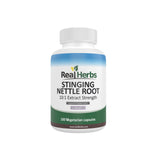Can You Eat Stinging Nettle Root?
Stinging nettle, also known as Urtica dioica, is a perennial plant that has a long history of medicinal use. With its vibrant green leaves and small, needle-like hairs that sting when touched, nettle has piqued people's interest in its consumption, particularly the root. We will look at the nutritional profile, potential health benefits, and safety concerns of consuming stinging nettle root in this article.
Stinging Nettle Root Nutritional Profile: Stinging nettle root contains a variety of nutrients that can help you maintain a healthy diet. It contains vitamins A, C, and K, all of which are essential. Nettle root is also high in minerals like iron, calcium, magnesium, and potassium. These nutrients are critical for overall health and well-being.
Health Benefits: Consuming stinging nettle root has been linked to a number of potential health benefits. According to some studies, nettle root may have anti-inflammatory properties, making it useful for people suffering from conditions such as arthritis. Because of its effects on certain hormones, it may also benefit prostate health in men. Furthermore, stinging nettle root has traditionally been used to promote urinary tract health and as a diuretic.
While stinging nettle root appears to have promising health benefits, it is important to be aware of potential safety concerns. The most noticeable feature of stinging nettle is its stinging action, which can cause skin irritation if not handled properly. Wear gloves whenever you handle fresh nettle plants as a precaution.
Furthermore, some people may have allergic reactions to stinging nettle if they come into contact with it or consume it. If you have a history of allergies, especially to plants in the Urticaceae family, avoid consuming stinging nettle root or nettle-containing products.
Pregnant women and people with certain medical conditions, such as kidney disease or diabetes, should avoid consuming stinging nettle root. Because stinging nettle may interact with certain medications, it is critical to consult a healthcare professional before incorporating it into your diet.
Preparation and Consumption: If you decide to include stinging nettle root in your diet, you must take the necessary precautions. The root is typically dried, crushed, and prepared as a capsule or tea supplement. Cooking or drying the leaves and roots can also reduce the stinging sensation, making them safe to eat.
For an extra nutritional boost, try adding dried nettle root to soups, stews, or smoothies. Another popular way to reap its potential benefits is to drink nettle tea.
Conclusion:
Because of its nutritional content and potential health benefits, stinging nettle root can be a valuable addition to a well-balanced diet. However, due to the possibility of allergic reactions and medication interactions, it is critical to proceed with caution. Before incorporating stinging nettle root into your daily routine, as with any dietary change or supplementation, consult a healthcare professional.
References:
Johnson, T.A., Sohn, W.D. Inman, L.F. Bjeldanes, and K. Rayburn. Lipophilic stinging nettle extracts are anti-inflammatory, non-cytotoxic, and may be superior to traditional tinctures for treating inflammatory disorders. PMID: 23380245. Phytomedicine. 2013 Mar 15;20(5):414-7. doi: 10.1016/j.phymed.2012.12.005. Epub 2013 Jan 31.
L. Konrad, H. Müller, C. Lenz, H. Laubinger, G. Aumüller, and J. Lichius. A stinging nettle root (Urtica dioica) extract inhibited the proliferation of human prostate cancer cells. PMID: 10705732. Planta Med. 2000 Feb;66(1):44-7. doi: 10.1055/s-0029-1243167.












